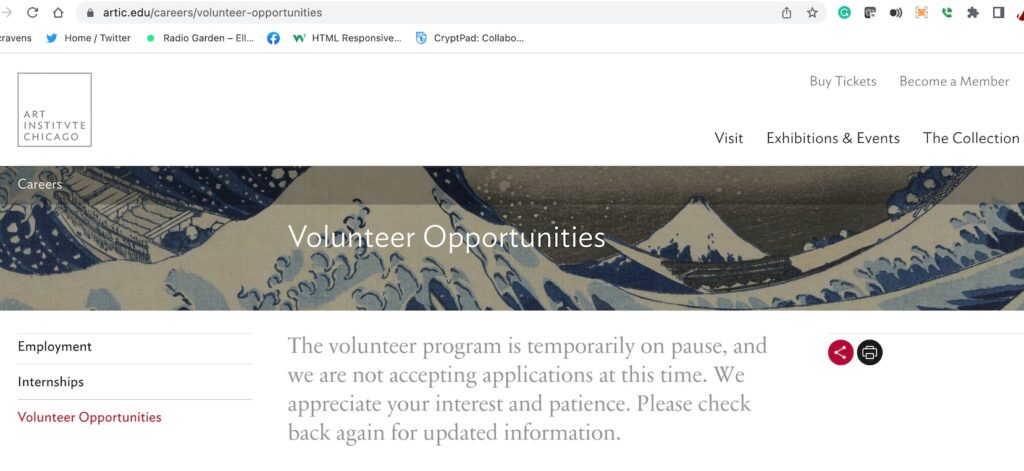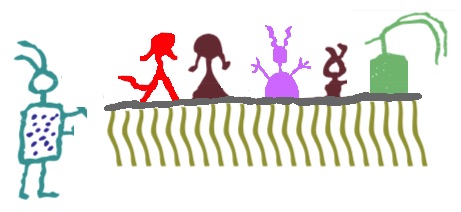The entire membership of the Art Institute of Chicago docent program, all volunteers, are being let go by the museum in an effort to entirely revamp how art education for museum visitors is staffed and to make such staffing much more diverse.
It is a move that has hurt long-time volunteers and outraged right-wing media, but many say it’s the only way to dismantle a system that, intentionally or not, is designed to exclude many people from participating.
On Sept. 3, Veronica Stein, the AIC’s executive director of learning and public engagement, emailed 82 active docents, telling them the program’s current iteration would be coming to an end. Stein told the Wall Street Journal that the museum must move “in a way that allows community members of all income levels to participate, responds to issues of class and income equity, and does not require financial flexibility.” In the letter, Stein said the museum “had a responsibility to rebuild the volunteer educator program in a way that allows community members of all income levels to participate, responds to issues of equity, and does not require financial flexibility to participate.” The AIC told USA TODAY that the pause is part of a “multi-year transition” to a “hybrid model that incorporates paid and volunteer educators.”
“Rather than refresh our current program, systems, and processes, we feel that now is the time to rebuild our program from the ground up,” Stein said in the letter, noting that current docents would be invited to apply for the paid positions.
While the elimination of docents struck many as sudden, it had actually been in the works for years, according to artnet news: the AIC stopped training new docents in 2012, and has been discussing internally how to restructure the program since 2019.
The institute’s docent council sent a letter Sept. 13 protesting the pause of the program. The letter described the docents’ expertise, noting that volunteers had trained twice a week for 18 months, done five years of research and writing, and participated in monthly and biweekly trainings. “For more than 60 years, volunteer docents enthusiastically have devoted countless hours and personal resources to facilitate audience engagement in knowledgeable, relevant, and sensitive ways,” the letter said.
Gigi Vaffis, president of the AIC’s docent council, told USA TODAY that she and other docents felt blindsided by the decision and weren’t included in the decision-making. Even now, she said there are few details about what the AIC’s multi-year plan will look like.
Docent programs have long been mainstays of major museums. Docents are all volunteers and are beloved by museum visitors. Becoming a docent can be quite competitive: not everyone who applies is accepted, and docents that get into the program stay for years, even decades. And involving volunteers is a sign a nonprofit wants the community to be a part of the organization – not just as donors or clients but also as people delivering services. But docent ranks at museums are often skewed toward a certain demographic: wealthy white women. The intention of the Chicago Institute is to dismantle this traditionally very rigid system that, intentionally or not, is designed to include/favor one, very privileged group and to exclude others.
Museum equity consultants have long advocated for transitioning volunteer positions at museums to paid roles, to encourage more diversity, allowing people who could never afford to give the time current docents give without pay. Monica Williams, executive producer of The Equity Project, a Colorado-based equity, inclusion and diversity consulting firm, who is NOT involved with the Art Institute, said this shift will open the doors for people who cannot afford to work on weekdays or do a significant amount of unpaid work. If docent programs switch to paid positions, she said it will help museums move away from “a particular demographic of mostly white and wealthy.”
Mike Murawski, a museum consultant and author of “Museums as Agents of Change,” said in the USA Today article that there has long been a tension between equity efforts and volunteer programs. When the Smithsonian’s Hirshhorn Museum ended its docent program in 2014 in favor of an initiative for younger volunteers who often work for college credit, Murawski said there was an uproar with many saying the museum might as well close. But now, he said. “they’re doing just fine.” Murawski is one of many museum consultants that says the way forward is not about making changes to programs, but to completely dismantle them and start over, and that docent programs often have “long-standing legacies of how things are supposed to be” that can make them difficult to adapt.
A side note: the Chicago Tribune, a once-great newspaper which was recently bought by Alden Global Capital, a secretive hedge fund that gutted the staff at the newspaper, wrote an outrageous editorial that had this jaw-dropping and completely misleading statement:
Volunteers are out of fashion in progressive circles, where they tend to be dismissed as rich white people with time on their hands, outmoded ways of thinking and walking impediments to equity and inclusion. Meaningful change, it is often said, now demands they be replaced with paid employees.
This is just flatly not true and the Tribune should be ashamed of itself.
As for me and my opinion: I don’t think programs should always be overly-cautious and ever-fearful of upsetting current, long-term volunteers – quite frankly, I think some long-term volunteers can have an entitled attitude that can discourage, even kill, much-needed changes and innovations. But I also feel like there was a better way to handle this transition. Absolutely, there are MANY systems related to nonprofits, including volunteer engagement, that have been exclusionary. But couldn’t current volunteers, who have invested a great deal of time in their roles, have been involved in the decision-making process, and perhaps, even bought into it? Also, will there still be a way for people to volunteer for the Art Institute – will there still be a community engagement component that isn’t donating funds or attending events?
If you have an example of a museum that significantly revamped its volunteering program so that it was vastly more diverse, but without having to fire the entire volunteer corps, please note such in the comments. Also note if it continued to have a volunteer program of some kind.
With all that said – what do you think?
October 17 update: the Art Institute of Chicago is, apparently, STILL not involving volunteers at all. Below is a screen capture from its volunteer page that notes “the volunteer program is temporarily on pause, and we are not accepting applications at this time.”

Also see:
- Managers of volunteers & resistance to diversity
- Decolonizing International Aid (including international volunteering)
- Accessibility, diversity & virtual volunteering
- Video Advocating for Diversity in Volunteer Engagement is NOT Easy: a 11:45 video about the pushback you will get when you talk about the need for diversity in volunteer engagement (2020).
- Recruiting Local Volunteers To Increase Diversity Among the Ranks (also explores the WHY)
- Systemic Exclusion in Volunteer Engagement
- More: systemic racism in volunteer engagement
- Welcoming immigrants as volunteers at your organization
- Why Should the Poor Volunteer? It’s Time To Re-Think the Answer
- Volunteer Bill of Rights – a commitment by a host organization to volunteers
- Infuriating statements about volunteering
- UN Agencies: Defend your “internships”
- Fight against unpaid internships will hurt volunteering
- Advice for unpaid interns to sue for back pay


Someone submitted a comment but asked to not be identified. Here are her comments in full:
I work for a large volunteer program that has similar issues as the Art Institute, but even suggesting a similar move would have severe blowback that I don’t dare contemplate – not just among volunteers but among stakeholders and funders. I wonder about creating a parallel online space that seeks to accomplish the organization’s educational mission while engaging volunteers and communities underserved by the current face-to-face model, which, like the Art Institute, attracts a narrow demographic participants. Surveys tell us that a majority of people – just not the current corps of volutneers – want to engage online, so I think it could work. If anyone’s tried this, I wonder how it went.